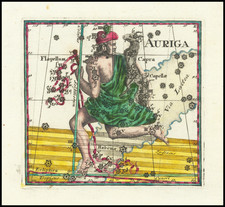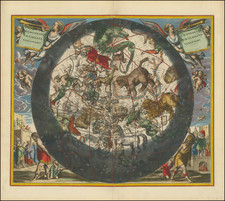Fine example of the map of the Constellation Bootes, from Bayer's Uranometria.
The stars on the map are heightend in gold. In the blank margins, an early owner has inscribed the names of the neighboring constellations.
Perhaps the most illustrious of all celestial atlases is Bayer's Uranometria, the forerunner of all star atlases which contained 51 star charts, of which 48 were Ptolomeic constellations. Each plate has a carefully engraved grid, so that star positions can be read off to fractions of a degree. These positions were taken,from the catalog of Tycho Brahe, which had circulated in manuscript in the 1590s, but which was only printed in 1602.
Another important feature of the atlas was the introduction of a new system of stellar nomenclature. Bayer assigned Greek letters to the brighter stars, generally in the order of magnitude, so that the bright star in the Bull's eye became alpha Tauri (and the brightest star in the Centaur became our familiar alpha Centauri.) These letters were placed on the charts themselves, and also in a table that accompanied each chart.
Exactly whom Boötes is supposed to represent is not clear. According to one version, he was a ploughman who drove the oxen in the constellation Ursa Major using his two dogs Chara and Asterion (from the constellation Canes Venatici). The oxen were tied to the polar axis and so the action of Boötes kept the heavens in constant rotation.
Boötes was also supposed to have invented the plough. This is said to have greatly pleased Ceres, the goddess of agriculture who asked Jupiter to give Boötes a permanent fixture in the heavens as a reward for doing this.
Another version portrays Boötes as a grape grower called Icarius, who one day invited the Roman god Bacchus, also called Dionysus, to inspect his vineyards. Bacchus revealed the secret of wine making to Icarius, who was so impressed by this alcoholic beverage that he invited his friends round to sample it. Having never tasted wine before, they all drank too much and woke up the next morning with terrible hangovers; and they made the mistaken assumption that Icarius had tried to poison them. It was decided that Icarius should pay the price with his own life, and he was swiftly murdered in his sleep. Bacchus placed Icarius in the stars to honor him.
Following another reading the constellation is identified with Arcas, son of Zeus and Callisto. Arcas was brought up by his maternal grandfather Lycaon, to whom one day Zeus went and had a meal. To verify that the guest was really the king of the gods, Lycaon killed his grandson and prepared a meal made from his flesh. Zeus noticed and became very angry, transforming Lycaon into a wolf and gave back life to his son.
In the meantime Callisto had been transformed into a she-bear, by Zeus' wife, Hera, who was angry at Zeus' infidelity. When he was grown up, Arcas met with the she-bear and, since obviously he didn't recognize her as his mother, he began to chase Callisto. Callisto, followed by Arcas, sheltered herself in a temple, a sacred place whose profaners were convicted to death. To avoid such fate, Zeus decided to set them in the sky, Arcas as Boötes and Callisto as Ursa Major.
Boötes was considered to be Atlas by some ancient Greek legends, as well as those in other early Mediterranean cultures, since it takes an appropriate position in the sky (its arms near the pole star, but its body standing on/near the ecliptic). As such, together with earlier interpretations of other constellations in the zodiac sign of libra (i.e. of Draco (constellation), Ursa Major and Ursa Minor it may have formed the origin of the myth of the apples of the Hesperides, which forms part of The Twelve Labours of Heracles.

![[Bootes] By Johann Bayer](https://storage.googleapis.com/raremaps/img/small/83178.jpg)








![[ Crater ]](https://storage.googleapis.com/raremaps/img/small/70467.jpg)
![[Cepheus]](https://storage.googleapis.com/raremaps/img/small/83186.jpg)
![[Constellations, No. 9]](https://storage.googleapis.com/raremaps/img/small/81822.jpg)

![[The October, November, and December Sky -- Aquarius, Andromeda, Pisces, Pegasus, Aries, Phoenix, Grus, Lacerta, Triangle, etc.]](https://storage.googleapis.com/raremaps/img/small/82779.jpg)
